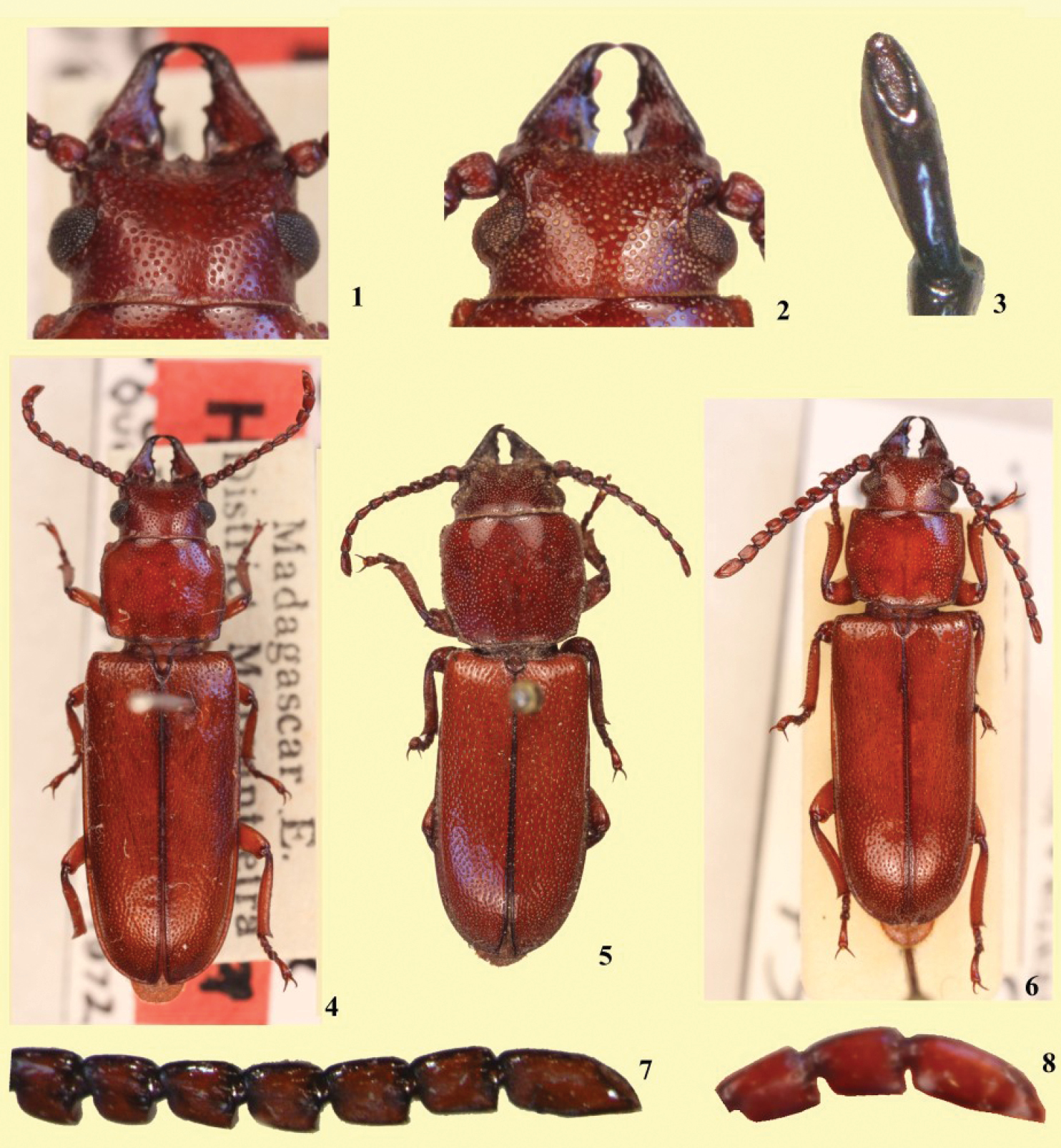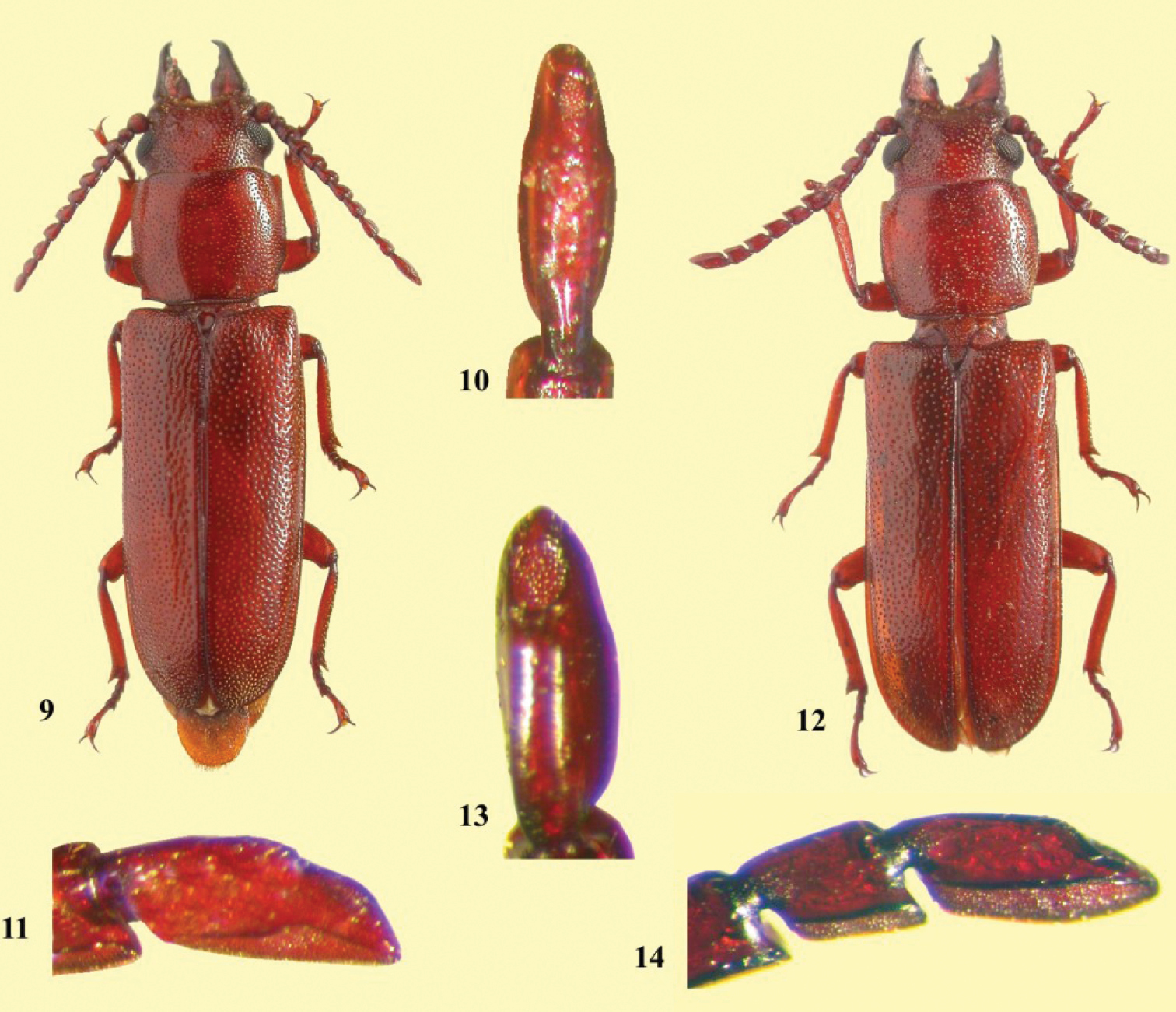(C) 2011 Ziro Komiya. This is an open access article distributed under the terms of the Creative Commons Attribution License, which permits unrestricted use, distribution, and reproduction in any medium, provided the original author and source are credited.
For reference, use of the paginated PDF or printed version of this article is recommended.
Two new species of the genus Stenandra Lameere, 1912 are described: Stenandra saitoae from Sulawesi of Indonesia and Stenandra asiatica from Vietnam. A key to the species of the Stenandra is given.
new species, Sulawesi, Vietnam
Recently,
Stenandra differs from all other genera of Parandrini, except Neandra Lameere, 1902, by the absence of a paronychium. From Neandra, an exclusively North American genus, it differs by the presence of setae on the elytra (glabrous in Neandra).
In the redescription of the genus in
The presence of Stenandra in Vietnam and Sulawesi suggests that the genus probably occurs in other areas of the Oriental zoogeographical region, possibly in Borneo. However, specimens of the genus from Africa are poorly represented in collections. The Muséum National d’Histoire Naturelle (Paris, France) apparently has the largest collection of Stenandra and researchers that have collected extensively in Africa in the last several years, such as Norbert Delahaye and Karl Adlbauer, have got very few specimens. Outside of Africa and Madagascar, the two females studied here are all that are so far. According to Tavakilian (pers. comm.) the males of the genus seem to be particularly rare but we are looking forward to the first male, as well as additional females, from the Oriental region.
In this paper, we describe two new species of Stenandra and provide a key to the species in the genus.
The collection acronyms used in the text are as follows:
MZSP Museu de Zoologia, Universidade de São Paulo, São Paulo, Brazil;
NSMT National Museum of Nature and Science, Tokyo, Japan.
Key to the species of Stenandra| 1 | Distance between anterior apex of upper eye lobe and posterior end of antennal insertion equal to the length of scape (Fig. 1). Madagascar | Stenandra vadoni Quentin & Villiers, 1972 |
| – | Distance between anterior apex of upper eye lobe and posterior end of antennal insertion much shorter than the length of scape (Fig. 2) | 2 |
| 2 (1) | Carina of ventral sensorial area of antennomeres III-XI not visible in lateral view (Figs 7, 8) (sometimes slightly visible at apical antennomeres). Intertropical Africa | Stenandra kolbei (Lameere, 1903) |
| – | Carina of ventral sensorial area of antennomeres III-XI distinctly visible in lateral view (primarily the apical antennomeres) (Figs 11, 14) | 3 |
| 3 (2) | Dorsal sensorial area of antennomere XI shorter than one-sixth of total length (Fig. 10); elytral suture divergent apically. Indonesia (Sulawesi) | Stenandra saitoae sp. n. |
| – | Dorsal sensorial area of antennomere XI longer than one-fourth of total length (Fig. 13); elytral suture not divergent apically. Vietnam | Stenandra asiatica sp. n. |
Stenandra vadoni Quentin & Villiers, 1972, holotype male 1 Head, dorsal view 4 Habitus 8 Antennomeres, lateral view. Stenandra kolbei (Lameere, 1903) 2 Head, dorsal view, female 3 Antennomere XI, dorsal view 5 Male, habitus 6 Female, habitus 7 Antennomeres, lateral view, female. Photos from Gérard Tavakilian (MNHN), except figure 3 (from Kiyoshi Matsuda, Japan – specimen from MNHN).
urn:lsid:zoobank.org:act:FDDB9174-8FB0-4B5F-8DE9-45C1E8CE97BD
http://species-id.net/wiki/Stenandra_saitoae
Figs 9–11Dedicated to Dr. Akiko Saito of the Natural History Museum and Institute, Chiba, who collected the holotype.
Stenandra saitoae sp. n. (Fig. 9) differs from Stenandra vadoni Quentin & Villiers, 1972 (Fig. 4), mainly by anterior upper eye edge (Fig. 9) placed close to base of antennae (distant from base of antennae in Stenandra vadoni – Fig. 1). From Stenandra kolbei (Lameere, 1903) (Fig. 6) it differs by the carina of ventral sensorial area of antennomeres III-XI distinctly visible in lateral view (Fig. 11), dorsal sensorial area of antennomere XI small (Fig. 10), antennomeres enlarged towards inferior edge (Fig. 10), and suture of the elytra apically divergent. In Stenandra kolbei, the carina of ventral sensorial area of antennomeres III-XI is not or very slightly visible in lateral view (Fig. 7), the dorsal sensorial area of antennomere XI is large (Fig. 3), antennomeres not distinctly enlarged towards inferior edge (Fig. 3), and the elytral suture is not divergent at the apex. From Stenandra asiatica sp. n. it differs mainly by the small sensorial area of antennomere XI (Fig. 10), the more sparse elytral punctation, and by the elytral suture divergent apically.
Female: Integument dark-brown; parts of the mandibles, margins of the pronotum, elytral suture, pro- and mesosternal process, trochanters, extreme ventral apex of tibiae blackish; elytra laterally and apically darker than the remaining surface.
Dorsal area of head coarsely punctate; punctures sparser at central area, coarser, more abundant and confluent at side; punctures between upper eye lobes with short, apically spatulate setae; punctures between posterior eye margin and margin of pronotum with very short, thick setae. Area behind eyes coarsely, confluently punctate near apices of upper eye lobes, sparsely near lower eye lobes; nearly all punctures with single, very small, thick seta. Clypeus coarsely, densely punctate, except at smooth central area; punctures with short, spatulate setae. Labrum smooth, glabrous laterally; coarsely punctuate; with short, spatulate setae around central projection. Upper eye lobe not notably separated from base of antenna. Submentum coarse; densely punctate near anterior margin (confluently centrally), sparsely and coarsely near gena; each puncture with a small, spatulated seta; anterior edge slightly elevated throughout. Mentum with dense, spatulate setae, somewhat longer laterally. Mandibles punctate; external punctures coarse, deep, dense and accompanied with spatulate setae; internal punctures sparse. Carina of ventral sensorial area of antennomeres elevated and visible in lateral view (Fig. 11), mainly after antennomere VIII; dorsal sensorial area of the antennomere XI (Fig. 10) elliptic, small, not reaching apex of antennomere; antennomere XI distinctly and abruptly sloped dorsally just after middle; antennomeres distinctly enlarged towards inferior edge (Fig. 10), more distinctly after antennomere IV.
Pronotum finely, sparsely punctate; punctures gradually becoming coarser and more abundant near lateral margin; lateral punctures with very small, spatulate seta. Prosternum coarsely, moderately densely punctate; nearly all punctures with small, spatulate seta. Prosternal process sparsely punctate (punctures with same type setae as prosternum). Mesosternum strongly, densely, deeply, confluently punctate, with a few very small, spatulated setae. Mesosternal process subglabrous and smooth. Mesepisterna coarsely, moderately densely punctate. Metasternum finely and sparsely punctate centrally; punctures gradually becoming coarser and denser towards lateral area; punctures close to metacoxae with small, spatulate setae. Elytra coarse; punctures dense on lateral parts and apical one-fourth; lateral punctures with very small thick setae, more conspicuously towards apices; punctures of apical one-third with small, spatulate setae; suture divergent at apex.
Urosternites densely punctate, mainly laterally; setae short, dense and spatulate, thick laterally; urosternite V with somewhat long, dense setae at margin, more conspicuous centrally (each seta apically spatulate). Coxae moderately sparsely punctate. Tibiae somewhat flat dorsally and sulcated laterally. Metatarsomere V (excluding claws) longer than I-III together.
Dimensions in mm (♀). Total length (including mandibles), 13.4; prothorax: length, 2.5; anterior width, 2.9; posterior width, 2.7; humeral width, 3.4; elytral length, 7.9.
Stenandra saitoae sp. n., holotype female 9 Habitus 10 Antennomere XI, dorsal view 11 Antennomere XI, lateral view. Stenandra asiatica sp. n., holotype female 12 Habitus 13 Antennomere XI, dorsal view 14 Antennomere XI, lateral view.
Holotype ♀ from INDONESIA, Sulawesi, South East Sulawesi: Konda (Kendari, Telkom Popalia; 1600 m; at light), 31.XII.2001, Akiko Saito col. (NSMT).
urn:lsid:zoobank.org:act:09AFC79D-E410-447C-B434-F78D31627F99
http://species-id.net/wiki/Stenandra_asiatica
Figs 12–14The name refers to the continent where the species occurs.
Stenandra asiatica sp. n. (Fig. 12) differs from Stenandra vadoni (Fig. 4) and Stenandra kolbei (Fig. 6) by the same characters of Stenandra saitoaesp. n. from Sulawesi, except the size of the dorsal sensorial area of the antennomere XI, which is large, and by the elytra not divergent apically (both similar to Stenandra kolbei). See diagnosis on Stenandra saitoae sp. n.
Female: Integument dark-brown; parts of mandibles, margins of pronotum, elytral suture, pro- and mesosternal process, trochanters, extreme ventral apices of tibiae blackish.
Dorsal face of head punctate coarsely for the most part; punctures sparser at central area, and coarse, dense and confluent near each side; punctures on area between upper eye lobes with short setae (lateral ones apically spatulate), more abundant near clypeus; punctures on area between posterior eye lobe and pronotum without setae. Area behind eyes coarsely punctate near the apices of upper eye lobes, sparsely near lower eye lobes; most punctures at the area close to upper eye lobe with a very small seta, slightly thicker at apex. Clypeus coarsely and densely punctate; punctures with short, spatulate setae. Labrum smooth and subglabrous except area near central projection with coarse punctures and short setae, in part spatulate, some only thick or acute apically. Upper eye lobe not notably distant from the base of antenna. Submentum coarse, moderately, densely punctate near anterior margin (confluently so centrally), gradually becoming sparse and coarse towards gena; each puncture with single, small seta (nearly all thicker apically; some of them spatulate; some acute apically); anterior margin slightly elevated throughout. Mentum with moderately sparse spatulate setae which somewhat longer laterally. Mandibles coarse; external punctures deep and dense, with small setae (very few spatulate); internal ones sparse. Carina of ventral sensorial area of antennomeres elevated and visible in lateral view (Fig. 14), mainly after antennomere VI; dorsal sensorial area of antennomere XI (Fig. 13) elliptic, large, almost reaching apex of antennomere; antennomere XI not abruptly sloped dorsally beyond middle; antennomeres distinctly enlarged towards inferior edge (Fig. 13), more distinctly after the antennomere IV.
Pronotum finely, sparsely punctate centrally, gradually becoming more coarsely and densely punctate laterally; lateral punctures with very small, spatulate seta. Prosternum coarsely, moderately, densely punctate, and nearly all punctures with small, apically spatulate seta. Prosternal process with small and spatulate setae. Mesosternum, densely, deeply, confluently punctate, and with small, spatulate setae. Mesepisterna coarsely, moderately, densely punctate. Metasternum finely and sparsely punctate centrally; punctures gradually becoming coarse, moderately abundant towards lateral area; lateral punctures close to metacoxae with small setae some of which spatulate. Elytra coarse; punctures dense on lateral parts and apical third; lateral punctures with very small seta, thicker towards apex and conspicuous from base to apex; nearly all punctures with small seta, more distinct towards apex (many spatulate, at least apically); suture not divergent at apex.
Urosternites densely punctate, mainly laterally; setae short, dense and spatulate (at least apically), mainly laterally; urosternite V with somewhat long, dense setae at margin, more conspicuous centrally (very few of them apically spatulate). Coxae moderately, sparsely punctate. Tibiae somewhat flat dorsally, and sulcate laterally. Metatarsomere V (excluding claws) longer than I-III together.
Dimensions in mm (♀). Total length (including mandibles), 17.4; prothorax: length, 3.2; anterior width, 3.5; posterior width, 3.2; humeral width, 4.4; elytral length, 9.8.
Holotype ♀ from VIETNAM, Vinh Phuc: Tam Dao National Park, VII.14-27.1992, N. Katsura col. (MZSP).
We are grateful to Drs. Shusei Saito of Japanese Wildlife Research Center, Akiko Saito of the Natural History Museum and Institute, Chiba, Gérard L. Tavakilian of Muséum National d’Histoire Naturelle, Paris, France, Mrs. Nobuhiko Katsura, Tokyo, Japan, Norbert Delahaye, Brussels, Belgium, Dr. Karl Adbauer, Graz, Austria, and Kiyoshi Matsuda, Takarazuka, Japan for their help in providing material and in many other matter in preparation of the present study.








